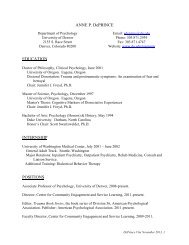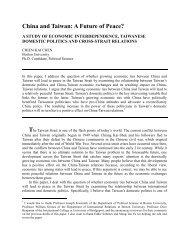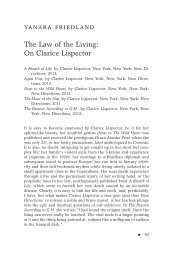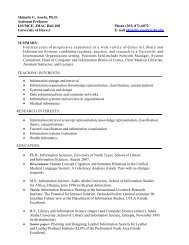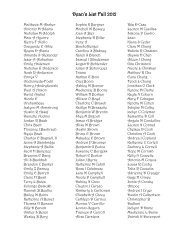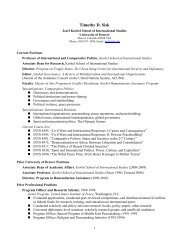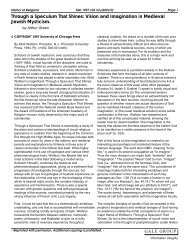Policy Memo Requirements & Guidelines 2012-2013 edition
Policy Memo Requirements & Guidelines 2012-2013 edition
Policy Memo Requirements & Guidelines 2012-2013 edition
You also want an ePaper? Increase the reach of your titles
YUMPU automatically turns print PDFs into web optimized ePapers that Google loves.
<strong>Policy</strong> <strong>Memo</strong> <strong>Requirements</strong> &<br />
<strong>Guidelines</strong><br />
<strong>2012</strong>-<strong>2013</strong> <strong>edition</strong><br />
Prepared for: IPPS Master In Public <strong>Policy</strong> Program<br />
August 27, <strong>2012</strong><br />
Institute for Public <strong>Policy</strong> Studies 2199 S. University Blvd. T 303.871.2468 E ipps@du.edu http://www.du.edu/ahss/centers/ipps/index.html
Institute for Public <strong>Policy</strong> Studies<br />
<strong>Requirements</strong><br />
Purpose<br />
In response to the MPP student’s need to experience first-hand the type of practical and professional work typical of a<br />
policy analyst, the Graduate Program in Public <strong>Policy</strong> requires all students to produce a “<strong>Policy</strong> <strong>Memo</strong>randum.”<br />
The project is designed to provide MPP students with a capstone experience that will synthesize the knowledge and<br />
skills that were acquired during the 56-quarter hours of formal coursework. Included among the skills that students will<br />
apply to the <strong>Policy</strong> <strong>Memo</strong>randum are problem definition, critical analysis, research, quantitative methods, economic<br />
analysis, and cost-benefit analysis.<br />
Defining the <strong>Policy</strong> <strong>Memo</strong>randum<br />
The <strong>Policy</strong> <strong>Memo</strong>randum is a practical and professional document that will represent the level of work that is expected<br />
from modern professional policy analysts.<br />
Students will:<br />
• Identify and define a real-world policy issue<br />
• Analyze the issue by interviewing professionals with opposing views, conducting research, and gathering data<br />
• Analyze the costs and benefits of the issue<br />
• Recommend courses of action<br />
Topic Choice<br />
The appropriate topic of study for the <strong>Policy</strong> <strong>Memo</strong>randum will:<br />
• Involve a policy decision within the public, private, or nonprofit sectors<br />
• Require a precise problem statement<br />
• Involve conflicting viewpoints or alternative points-of-view<br />
• Require careful delineation of actors and stakeholders<br />
• Involve the use of information, both qualitative and quantitative<br />
• Be specific to relevant issues; not general<br />
• Require cost - benefit analysis<br />
Length, Formatting and Submission<br />
The <strong>Policy</strong> <strong>Memo</strong>randum is expected to be 30-40 pages, including tables and charts, excluding endnotes and reference<br />
list. The standard formatting that should be used is 11-point “Times” font, double-spaced with 1” margins.<br />
<strong>Policy</strong> <strong>Memo</strong>randum <strong>Guidelines</strong> 1
Institute for Public <strong>Policy</strong> Studies<br />
Students must submit four unbound copies on the date of final submission. One-week after the presentation, students<br />
must submit an additional two bound copies to Mary Reed 107.<br />
Organization<br />
There should be seven main sections to the <strong>Policy</strong> <strong>Memo</strong>randum:<br />
1. Problem definition<br />
2. Methods<br />
3. Issue analysis<br />
4. Proposed solutions<br />
5. Strategic recommendations<br />
6. Weaknesses and limitations<br />
7. Cost-Benefit Analysis<br />
Students may add sections or sub-sections to this general guideline, but should not omit any of these seven primary<br />
areas.<br />
In addition, students are required to produce a one-page executive summary of their memorandum (see below for<br />
guidelines).<br />
<strong>Policy</strong> <strong>Memo</strong>randum Preparation Process<br />
In the spring and perhaps the early fall there will be a number of required seminars with faculty to discuss the goals and<br />
objectives of this project. In addition students will be required to submit a formal written policy memorandum proposal<br />
following the deadlines reported in this document. Students will be notified whether their topic is accepted, rejected or if<br />
modifications are required. Please see the ‘Deadlines’ section for the deadline for the submission of a topic proposal.<br />
Students should plan to do substantial research to prepare their policy proposal between June and September when<br />
classes begin.<br />
Students may request a specific faculty adviser in their written topic proposal but such requests may not always be<br />
honored due to the need to have advising duties evenly divided among faculty. The CBA adviser will not be a student's<br />
primary adviser.<br />
Credit Hours<br />
Students must register for four-quarter hours of required credit in the Public <strong>Policy</strong> Program (PPOL 4995, Independent<br />
Research). These four credits are generally taken during Winter quarter, but may be taken anytime during the student's<br />
final year if necessary. In order to register for the credit, please make an appointment with Debbie Sheanin,<br />
debbie.sheanin@du.edu.<br />
<strong>Policy</strong> <strong>Memo</strong>randum <strong>Guidelines</strong> 2
Institute for Public <strong>Policy</strong> Studies<br />
Professional Ethics<br />
<strong>Policy</strong> <strong>Memo</strong>randum content should be the student's original thought–or properly attributed in accordance with<br />
recognized citation standards. Any unattributed content will result in a failing grade, with the consequence of a<br />
completely rewritten <strong>Policy</strong> <strong>Memo</strong>randum (on a new topic) or expulsion from the Program without the MPP degree. The<br />
Director and IPPS faculty will determine the consequences after review of the severity of the offense.<br />
Timeframe<br />
The due dates for the <strong>Policy</strong> <strong>Memo</strong>randum are strict. The advisor will consider the student’s ability to meet deadlines<br />
when determining the final grade.<br />
Deadlines<br />
See attached tables.<br />
Grading<br />
The student’s final grade will be determined as follows, for a total of 100 points:<br />
• student’s primary advisor (up to 40 points possible),<br />
• cost benefit analysis advisor (up to 20 points possible), and<br />
• panel members (up to 40 points possible).<br />
Students will be evaluated on their public policy problem definition; analytical abilities; thoroughness and quality of<br />
research; quality of writing; professionalism; and presentation skills, among others. If a student's final grade is lower than<br />
a B- (80 points), he or she must rewrite the portion(s) of the paper that need(s) improvement. The student’s graduation<br />
will be postponed until such time that an acceptable version (80 or more points) is submitted.<br />
Presentation<br />
The panel members will consist of the student’s primary advisor, the cost-benefit adviser, and one or more faculty or<br />
community members.<br />
The student will present for approximately 30 minutes, the panel members will discuss the student’s project and<br />
presentation (student is absent at this time) for 15 minutes, and finally, the student will answer questions from panel<br />
members and be critiqued for approximately 30 minutes.<br />
Professional attire and practiced presentation skills are expected.<br />
<strong>Policy</strong> <strong>Memo</strong>randum <strong>Guidelines</strong> 3
Institute for Public <strong>Policy</strong> Studies<br />
<strong>Guidelines</strong> I - Proposal<br />
Introduction<br />
We strongly recommend all students to consult Eugene Bardach’s A Practical Guide for <strong>Policy</strong> Analysis: The Eightfold<br />
Path to More Effective Problem Solving, 2nd ed. (Congressional Quarterly Press, 2005) to complete their topic proposal.<br />
Read the book carefully, since it provides you with a detailed step-by-step process to policy analysis.<br />
This section gives you an overview of the policy memo proposal. The ‘<strong>Guidelines</strong> II - <strong>Policy</strong> <strong>Memo</strong>’ section of the<br />
document gives you a detailed description of the requirements of each section of the policy memo.<br />
<strong>Requirements</strong><br />
Your policy memo proposal should be five pages, single-space. It should contain the following sections:<br />
Problem Definition<br />
• What is your problem definition? See Bardach pgs. 1-2.<br />
• Is your problem defined in terms of deficits and excesses? If yes, explain. If no, explain. See Bardach pg. 3.<br />
• What is the market failure of your problem? If there is no market failure, what is the situation that warrants definition<br />
as a public problem? See Bardach pgs. 4-5.<br />
• How will your problem include a quantitative feature? See Bardach pg. 5.<br />
• Is your problem diagnostic? If so, are you sure you want to define your problem in this manner? See Bardach pg. 6.<br />
• Did you define your solution into the “problem”? If yes, redefine the problem and iterate! See Bardach pgs. 7-10.<br />
• Do you have a causal claim? If so, is it “real”? Explain. See Bardach pgs. 7-8.<br />
Methods<br />
• Describe how you plan to find the information on which your <strong>Policy</strong> <strong>Memo</strong> is based.<br />
• Include a list of possible professionals to interview, databases to explore, websites to visit, books to read, legislative<br />
history to review, and peer-reviewed journals to digest.<br />
Proposed solutions<br />
• Write a brief review of the specific solutions you will evaluate.<br />
• With a few sentences on each of the ideas, establish the overall landscape of the debate, citing at least one<br />
proposal reflecting “conservative” and “liberal” ends of the political spectrum, plus at least two that may seem more<br />
moderate in approach.<br />
• Who are the stakeholders?<br />
<strong>Policy</strong> <strong>Memo</strong>randum <strong>Guidelines</strong> 4
Institute for Public <strong>Policy</strong> Studies<br />
Issue analysis<br />
• How do you plan to analyze/iterate the issue?<br />
• How is your “analysis” different from your “research”?<br />
• What will be your approach to the CBA?<br />
• What contribution will your analysis make to the current policy debate?<br />
Strategic recommendations<br />
• Do you have a preliminary idea of what you think will be the best recommendation?<br />
• If so, why?<br />
Weaknesses and limitations<br />
• What do you think will be the weaknesses of or limitations to this project?<br />
• For example, will you have access to all of the data that you may need?<br />
• Do you think your strategic recommendations will be realistic and politically feasible?<br />
Recommendations<br />
What we want to see in your proposal is that you have a fairly clear picture of the direction of your research. We want to<br />
see that you have:<br />
a) a clear grasp of the problem. This is why the problem definition part is so important. A clear problem definition will<br />
lead your research toward a well thought out solution. If you have a vague problem definition, then you won’t be able<br />
to identify what you want to solve with your policy, which means that your document will remain vague and therefore<br />
useless as a decision-making tool.<br />
b) Enough data to get your project started or at the very least a clear data-gathering strategy. When you complete<br />
your proposal, you should have a clear idea on what data to get, where, and if you are able to process it. If you have<br />
serious reservations about the availability of good data for your topic, you might want to switch to another topic.<br />
Without good data, you will not be able to perform your cost-benefit analysis.<br />
c) A thorough consideration of the challenges of your project. We want you to think hard about the issues<br />
associated with trying to solve the policy problem that you have chosen. Even the simplest policy issues have some<br />
complex ramifications. We want to see that you have given full consideration to i) the complexity of the issue and ii) its<br />
implications.<br />
d) A serious reflection on the limits of your analysis. Even though this is just a proposal, we want to see that you are<br />
starting to identify the possible weaknesses of your document. We know that no policy analysis document can be<br />
perfect. However, we want to see that you recognize the limits of your research, even at this early stage, and that you<br />
are ready to either address them or discuss them.<br />
<strong>Policy</strong> <strong>Memo</strong>randum <strong>Guidelines</strong> 5
Institute for Public <strong>Policy</strong> Studies<br />
To sum up, with your proposal you should be able to show us the skeleton of your policy memo. Your proposal should<br />
tell us that you have a plan to tackle the issue that you have chosen. Some of the details of your plan might change<br />
during the completion process, but its structure will carry on from the proposal.<br />
Please note that these structure will be the same for your final document (see below), with the addition of the Cost-<br />
Benefit Analysis section.<br />
Other <strong>Requirements</strong><br />
Please include a cover page for your topic proposal that includes the following information:<br />
• your name;<br />
• your email address;<br />
• your phone number ;<br />
• your mailing address ;<br />
• your expected date of graduation ;<br />
• your preference for advisor. Please note that not all requests can be granted because assigning advisors will also be<br />
dependent on faculty availability and your topic selection; please list both 1st and 2nd choices.<br />
Please list the following courses and note when you completed (or will complete) each course (quarter and year) and the<br />
grade you received in each.<br />
• PPOL 4100 (American <strong>Policy</strong> System)<br />
• PPOL 4200 (Microeconomics)<br />
• PPOL 4300 (Quantitative Analysis)<br />
• PPOL 4400 (Analytical and Critical Skills)<br />
• PPOL 4500 (Cost-Benefit Analysis)<br />
• PPOL 4600 (Regulatory <strong>Policy</strong>)<br />
• PPOL 4700 (Public Management and Budgeting)<br />
<strong>Policy</strong> <strong>Memo</strong>randum <strong>Guidelines</strong> 6
Institute for Public <strong>Policy</strong> Studies<br />
<strong>Guidelines</strong> II - <strong>Policy</strong> <strong>Memo</strong><br />
Overview<br />
The policy memorandum is a document that outlines the rationale for choosing a particular policy alternative or course of<br />
action in a current policy debate. It is commonly produced in response to a request directly from a decision-maker or<br />
within an organization that intends to advocate for the position detailed in the document. Depending on the role of the<br />
writer or organization producing the document, the memo may only provide a targeted discussion of the current<br />
alternatives without arguing for a particular one (i.e. those who adopt the role of ‘objective’ researcher). On the other end<br />
of the scale, i.e. advocates, the memo may focus directly on providing an argument for the adoption of a particular<br />
alternative. Nevertheless for any case, as any policy debate is a market place of competing ideas, the purpose of the<br />
policy memorandum is to convince the target audience of the urgency of the current problem and the need to adopt the<br />
preferred alternative or course of action outlined and therefore, serve as an impetus for action. Remember: a policy<br />
memorandum is a tool for decision-making; therefore, it has to provide decision-makers with the necessary information<br />
to make policy choices.<br />
Topic Choice<br />
The choice of your topic is extremely important for the success of your policy memorandum. As mentioned in the<br />
requirements, you should choose a topic that lends itself to policy analysis and therefore policy solutions. An appropriate<br />
topic has the following characteristics:<br />
• Precise: it is easily defined in straightforward terms. Example: “improving graduation rates in public schools” is a<br />
precise definition, whereas “improving education in the US” is not. A vague topic choice would be detrimental to the<br />
focus of your research. It would also lends itself to vague policy recommendations.<br />
• Specific: it is limited to a well-defined policy area and (possibly) to a well-defined domain. A specific topic will help you<br />
limit your research to the information that you actually need. Example: “Resource management in the US” would be a<br />
very general topic that has countless potential venues of research and analysis, whereas “Water management in<br />
Colorado” would focus your research on a specific resource (water) and on a specific geographic domain (Colorado).<br />
• Disputed: it lends itself to multiple approaches and points-of-view. If your topic is about an uncontroversial issue, then<br />
it is not going to command the attention of your audience; same if the solution to the problem is foregone.<br />
Features of the <strong>Memo</strong>randum<br />
An effective policy memorandum should have the following qualities:<br />
<strong>Policy</strong> <strong>Memo</strong>randum <strong>Guidelines</strong> 7
Institute for Public <strong>Policy</strong> Studies<br />
• Focused: all aspects of the memorandum should be strategically aimed at achieving the goal of convincing your<br />
target audience about the accuracy of your analysis and therefore the quality of your policy recommendations. Avoid<br />
lengthy digressions. Avoid anything that can distract the reader from the issue at hand<br />
• Professionally crafted: your document is a tool for decision-making. Keep it professional. Both the look and the<br />
content of the document should be polished, focused, easy to understand. Avoid copy-and-paste. Edit your document<br />
carefully: you should use professional language. Be passionate about your topic and your policy recommendations,<br />
but avoid hyperboles that could be detrimental to the credibility of your document.<br />
• Evidence-based: your audience (decision-makers) not only expect a rational argument but will only be convinced by<br />
argumentation supported by evidence that the problem exists and the consequences of adopting particular<br />
alternatives. You must include a cost-benefit analysis to your document if you want your policy recommendations to be<br />
taken seriously.<br />
• Understandable: you should use clear and simple language, avoiding the jargon and concepts of an academic<br />
discipline. You should also provide a well-explained and easy to follow argument. Again, avoid lengthy digressions;<br />
keep the structure of the document coherent and linear.<br />
• Accessible: you should make the document easy to use and therefore subdivide the text using clear and descriptive<br />
titles to guide the reader. The use of such structure also makes it easy to get back to specific sections of the paper for<br />
successive readings. If it is hard to find information in your document, policy makers will not use it.<br />
• Promotional: your document should catch the eye of its potential audience. Creating a favorable impression is<br />
essential to catch the attention of the reader. A poor-looking or poor-reading document is detrimental to its content.<br />
• Practical and feasible: your document should provide arguments based on what is actually happening in reality. Your<br />
policy recommendations should sound realistic to the target audience. Again, a cost-benefit analysis is essential to<br />
provide a seal of practicality and feasibility to your recommendations.<br />
• Explicit: given your policy recommendations, you should provide specific criteria to assess either the failure or the<br />
success of the policy changes you are recommending. This criteria should come as much as possible from your cost-<br />
benefit analysis.<br />
• Transparent: do not try to hide information that does not support your policy recommendations. Recognize the<br />
weaknesses of your analysis and be straightforward about it. Being transparent strengthens your argument.<br />
Organization / Sections of the <strong>Memo</strong>randum<br />
Your policy memorandum should include a one-page executive summary.<br />
The executive summary aims to convince the reader further that the brief is worth in-depth investigation. It is especially<br />
important for an audience that is short of time to clearly see the relevance and importance of the brief in reading the<br />
summary. As such, a one-page executive summary should include: a) a description of the problem addressed; b) a<br />
statement on why the current approach/policy option needs to be changed; c) your recommendations for action.<br />
<strong>Policy</strong> <strong>Memo</strong>randum <strong>Guidelines</strong> 8
Institute for Public <strong>Policy</strong> Studies<br />
What follows is a detailed guideline to drafting your policy memorandum.<br />
1. Problem Definition. You should clearly define the problem you intend to address in your policy memorandum. You<br />
should define your problem in a way that lends itself to policy solutions. A vague definition of the problem will hinder<br />
your search for policy solutions. You should also give a clear answer to this question: ‘why is this issue a problem?’<br />
That also answer the next question: ‘why should we dedicate our efforts to this?’ You should answer these<br />
questions in a clear and compelling fashion when you define your problem. Some people might think that the issue<br />
you chose is not even a problem: that is one of the reason why you make your definition as dispassionate as<br />
possible. Remember: do not define your solution into the problem. You should make it straightforward for the reader<br />
to understand why this is a problem; therefore, you should prepare a single sentence problem definition followed by<br />
additional necessary background or details in order to provide appropriate explanation and context.<br />
2. Methods. After you have defined your problem, you should devote your attention to gathering data/evidence about<br />
the issue. In this section, you should explain clearly what kind of evidence you gathered for your research and the<br />
reasons for your choice. Be candid and straightforward. If you wanted to gather ‘the perfect data’ for your research<br />
but you could not, explain why. Highlight the strong sides of your data but also the weak ones. When in doubt,<br />
always opt for transparency. It is important that you explain precisely what your criteria is for judging success or<br />
failure of your recommendation.<br />
3. Issue Analysis. In this section, you should analyze the issue with the tools of your choice (see ‘Methods’ section).<br />
Depending on the issue you are analyzing, it might be useful to provide some historical context, especially if the<br />
historical development of the issue at hand can provide some hints about how to treat the problem. Maybe there<br />
were some other attempts to solve the problem in previous times that failed, or maybe a similar problem has been<br />
addressed in a different context. Having a grasp of the development of the issue over time can help selecting viable<br />
alternatives amongst policy options. For example: a policy memo that addresses the issue of public housing should<br />
not forget to consider the failure of public housing policies in the past (‘The Projects’). Beyond historical information,<br />
your analysis will heavily depend on the methodological choices you made. Your analysis tool (hard data, surveys,<br />
etc.) will probably not allow you to take into consideration all the factors that contribute to the problem. This is<br />
unavoidable. Again, choose transparency and be candid about what you are ‘leaving out’ of your analysis. Your<br />
analysis should individuate the relevant stakeholders in the issue and address their interests. Possibly, you should try<br />
to quantify such interests, so you can factor them into your cost-benefit analysis. From a qualitative standpoint, you<br />
should also try to assess how intense stakeholders’ preferences are about different possible solutions to the<br />
problem. It is critical that you address the primary objections to your proposal and reach a conclusion on whether or<br />
not they are valid.<br />
4. Proposed solutions. In this section you will analyze the possible solutions to the problem of your policy<br />
memorandum. Here you should think hard about what kind of policies could address the problem you are analyzing.<br />
You should report solutions that are realistic and viable. If you decide to rule out some solutions, you should be<br />
transparent about what makes them unviable or unrealistic. Lay out the possible solutions clearly. Be straightforward<br />
about the components of the policy alternatives. Be clear about the conditions that would make a specific policy fail<br />
or succeed.<br />
<strong>Policy</strong> <strong>Memo</strong>randum <strong>Guidelines</strong> 9
Institute for Public <strong>Policy</strong> Studies<br />
5. Strategic Recommendations. This section is the result of your analysis. Here you should convince your audience<br />
that the policy you recommend is better than other alternatives. This implies giving a definition of what ‘better’<br />
means: you should set forth straightforward criteria to judge the success or the failure of policy. This definition of<br />
criteria will allow you to structure your cost-benefit analysis.<br />
6. Weaknesses and Limitations. In this part, you should analyze your own analysis and policy recommendations to<br />
find out what their weaknesses and limitations are. These might come from the data (e.g. you could not get enough<br />
data), context (e.g. conditions on the ground could vary in a few years), or other factors such as political will (e.g.<br />
“this could be the best way to tackle the issue but there is no way political leaders will green light it”). Past<br />
experience can also be a factor in assessing weaknesses and limitations (“we tried this before and it did not work”).<br />
This section should not be an afterthought. Hiding the potential weaknesses and limitations of your analysis will only<br />
make it weaker. Again, transparency makes for better analysis.<br />
7. Cost-benefit analysis. This section is devoted to assess the practical viability of your policy recommendations. In<br />
order to perform a sound cost-benefit analysis, you should be able to quantify the components of your<br />
recommendations. You should be straightforward about the sources of your figures. If you have to give estimates<br />
rather than hard figures, be straightforward about your estimation process. Some components of your issue might<br />
not be easily quantifiable; again, be transparent about such limitations of your analysis. As far as specific<br />
requirements go, the cost-benefit analysis should include a matrix consisting of stakeholders (in row form) and<br />
alternatives (in column form). One of the alternatives must be the status quo. The matrix should also include weights<br />
to address the issue of standing. A comprehensive CBA analysis will also include a matrix for sensitivity analysis and,<br />
if possible, one for political feasibility. The M.P.P. program at University of Denver emphasizes economic and<br />
quantitative skills. Successful completion of the program requires a combined total of one-year worth of courses in<br />
Microeconomics, Quantitative Analysis, and Cost-Benefit Analysis. In order to fulfill and pass the memorandum,<br />
students must discuss and explain concepts relating to consumer surplus, producer surplus, dead-weight loss,<br />
elasticity, asymmetric information, externalities, and provide appropriate graphs. Remember: ultimately, a sound<br />
cost-benefit analysis is the strongest support for your policy recommendation. If there are some doubts about the<br />
robustness of this part, there will be some doubts about the soundness of your policy solutions. The Cost-Benefit<br />
Analysis is an essential part of your memo: without it you WILL NOT complete your policy memo.<br />
Cost-Benefit Analysis Hints & Tips<br />
Dr. Sharma will be your advisor for the Cost-Benefit Analysis section of your memo. You should come well prepared to<br />
your meetings with him (see the schedule in the ‘Deadlines’ section below). That will ensure a smooth crafting of your<br />
CBA section. Before you meet with Prof. Sharma, we suggest you do the following:<br />
• First of all, examine the CBA sections of previous years' policy memos: those documents will give you a clear idea of<br />
what you are expected to produce.<br />
• Come prepared with all the material you have collected for your CBA section.<br />
<strong>Policy</strong> <strong>Memo</strong>randum <strong>Guidelines</strong> 10
Institute for Public <strong>Policy</strong> Studies<br />
• Be ready to show Dr. Sharma all the data you have. Data collection is one of your main research tasks. Do not expect<br />
your CBA advisor to do it for you.<br />
Here is how you could organize your data effectively before you meet with your CBA advisor:<br />
1. Draw a table (or an outline) containing your CBA parameters & data sources.<br />
2. In the table (or outline), show the data you need, divided in the parts that you already have and the ones you are still<br />
trying to collect.<br />
3. Connect the data sources with the parameters you will be using in your CBA matrix<br />
4. Highlight the parts that are complete and the ones that need more work. Explain what you are still missing and how<br />
you are going to fill that void.<br />
Following the steps above will help you rationalize the process of building your CBA section.<br />
<strong>Policy</strong> <strong>Memo</strong>randum <strong>Guidelines</strong> 11
Institute for Public <strong>Policy</strong> Studies<br />
Deadlines <strong>2012</strong>-<strong>2013</strong><br />
Please keep in mind that individual advisors can establish additional deadlines to the ones<br />
presented below.<br />
Most students are expected to graduate in Spring <strong>2013</strong>.<br />
Deadlines for Spring <strong>2013</strong> Graduation<br />
Date Task<br />
Monday, October 1, <strong>2012</strong> Topic proposal due (email to lapo.salucci@du.edu) by 3pm<br />
Monday, October 22, <strong>2012</strong> Revised topic proposal (if necessary) due to advisor by 5pm<br />
1 st -2 nd week of December <strong>2012</strong> Students are expected to have a first draft of the document ready, excluding CBA.<br />
Please agree on specific deadlines with your advisor.<br />
1 st week of February <strong>2013</strong> Students are expected to have a second draft of the memo ready, excluding CBA.<br />
Please agree on specific deadlines with your advisor. Be ready to meet with Prof.<br />
Sharma for your CBA: have your outer matrix and plan for constructing the inner<br />
matrix (data and calculations) ready. Please contact Prof. Sharma to set up a meeting<br />
date.<br />
2 nd week of March <strong>2013</strong> Students are expected to have a final or near final draft of their CBA ready. Please<br />
contact Prof. Sharma for specific deadlines.<br />
Monday, April 8, <strong>2013</strong> Final submission of <strong>Policy</strong> <strong>Memo</strong>randum to IPPS office (four unbound copies) by<br />
7pm; only very minor revisions will be accepted after this date<br />
Mid-April, <strong>2013</strong> All advisors will meet to review all <strong>Policy</strong> <strong>Memo</strong>s submitted and make a decision about<br />
whether each student will proceed to the presentation stage; if declined, students will<br />
need to revise their graduation plans to Summer <strong>2013</strong><br />
April 29-May 10, <strong>2013</strong> Student presentations (2 bound copies due one-week after presentation)<br />
<strong>Policy</strong> <strong>Memo</strong>randum <strong>Guidelines</strong> 12
Deadlines for Fall <strong>2012</strong> Graduation<br />
Date Task<br />
Monday, September 24, <strong>2012</strong> Final submission of <strong>Policy</strong> <strong>Memo</strong>randum to IPPS office (four unbound copies) by 7pm;<br />
only very minor revisions will be accepted after this date<br />
Mid-October, <strong>2012</strong> All advisors will meet to review all <strong>Policy</strong> <strong>Memo</strong>s submitted and make a decision about<br />
whether each student will proceed to the presentation stage; if declined, students will<br />
need to revise their graduation plans to Winter <strong>2013</strong>.<br />
Late-October, <strong>2012</strong> Student presentations (2 bound copies due one-week after presentation)<br />
Deadlines for Winter <strong>2013</strong> Graduation<br />
Date Task<br />
Monday, September 17, <strong>2012</strong> Topic proposal due (email to lapo.salucci@du.edu by 3pm<br />
Monday, October 1, 2011 Revised topic proposal (if necessary) due to advisor by 5pm<br />
1 st week of December <strong>2012</strong> 1st draft of <strong>Policy</strong> <strong>Memo</strong>randum due to advisor. Please agree on specific deadlines<br />
with your advisor.<br />
1 st week of January <strong>2013</strong> Students are expected to have a second draft of the memo ready, excluding CBA.<br />
Please agree on specific deadlines with your advisor. Be ready to meet with Prof.<br />
Sharma for your CBA: have your outer matrix and plan for constructing the inner<br />
matrix (data and calculations) ready. Please contact Prof. Sharma to set up a meeting<br />
date.<br />
4 th week of January <strong>2012</strong> Students are expected to have a final or near final draft of their CBA ready. Please<br />
contact Prof. Sharma for specific deadlines.<br />
Monday, February 18, <strong>2013</strong> Final submission of <strong>Policy</strong> <strong>Memo</strong>randum to IPPS office (four unbound copies) by<br />
7pm; only very minor revisions will be accepted after this date<br />
February 19-22, <strong>2013</strong> All advisors will meet to review all <strong>Policy</strong> <strong>Memo</strong>s submitted and make a decision about<br />
whether each student will proceed to the presentation stage; if declined, students will<br />
need to revise their graduation plans to Spring 2011<br />
February 25-Mar 1, <strong>2013</strong> Student presentations (2 bound copies due one-week after presentation)<br />
<strong>Policy</strong> <strong>Memo</strong>randum <strong>Guidelines</strong> 13
Deadlines for Summer <strong>2013</strong> Graduation<br />
Date Task<br />
Monday, January 7, <strong>2013</strong> Topic proposal due (email to lapo.salucci@du.edu) by 3pm<br />
Monday, January 21, <strong>2013</strong> Revised topic proposal (if necessary) due to advisor by 5pm<br />
1st week of April <strong>2013</strong> 1st draft of <strong>Policy</strong> <strong>Memo</strong>randum due to advisor. Please agree on specific deadlines<br />
with your advisor.<br />
1 st week of May <strong>2013</strong> Students are expected to have a second draft of the memo ready, excluding CBA.<br />
Please agree on specific deadlines with your advisor. Be ready to meet with Prof.<br />
Sharma for your CBA: have your outer matrix and plan for constructing the inner<br />
matrix (data and calculations) ready. Please contact Prof. Sharma to set up a meeting<br />
date.<br />
2 nd week of June <strong>2013</strong> Students are expected to have a final or near final draft of their CBA ready. Please<br />
contact Prof. Sharma for specific deadlines.<br />
Monday, July 1, <strong>2013</strong> Final submission of <strong>Policy</strong> <strong>Memo</strong>randum to IPPS office (four unbound copies) by<br />
7pm; only very minor revisions will be accepted after this date<br />
Early July, <strong>2013</strong> All advisors will meet to review all <strong>Policy</strong> <strong>Memo</strong>s submitted and make a decision about<br />
whether each student will proceed to the presentation stage; if declined, students will<br />
need to revise their graduation plans to Fall <strong>2013</strong><br />
July 8-12, <strong>2013</strong> Student presentations (1 bound copy and 3 unbound copies)<br />
<strong>Policy</strong> <strong>Memo</strong>randum <strong>Guidelines</strong> 14



